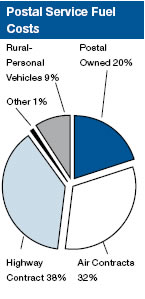2. Reduce Energy Use
Because of its size, the Postal Service has the opportunity and responsibility to lead the way in energy management. Energy use amounted to $2.35 billion in 2007; transportation consumes 75 percent, with the balance for utilities. This year energy initiatives focused on developing a common energy strategy for the organization and improving data quality. Transparency in overall cost and consumption will lead to significant improvements in facility energy management. Wise investments in energy efficient equipment today will pay dividends continuously over time.

Transportation
The Postal Service delivers to 148 million addresses each day, and its outreach grows by almost 2 million delivery points per year, making continued reduction of fuel consumption paramount. By optimizing its postal-owned fleet and seeking out the best value available in contract transportation, the Postal Service can reduce miles driven to manage fuel usage.
Although the Postal Service has the nation‘s largest civilian vehicle fleet, most transportation expenses are for contracted air and ground transportation. The Postal Service partners with suppliers to obtain serviceresponsive transportation at the best value. It also continues to refine the transportation network so that more mail will meet service commitments using ground transportation. In general, moving more mail from air to surface transportation offers improved performance while reducing fuel consumption.
For its own fleet of vehicles, the Postal Service will reduce miles driven while absorbing the addition of new deliveries each year. New computer modeling tools are helping delivery managers create more efficient routes to minimize fuel use. Carriers are being made aware of best practices to reduce vehicle idling, given the frequent starts and stops required on most routes. Improvements in mail processing will increase the number of deliveries per route and reduce the number of vehicles on the road. The Postal Service will continue to take advantage of opportunities to consolidate trips and centralize new deliveries.
The Postal Service operates the nation‘s largest alternative fuel-capable fleet, including more than 36,000 E85 flex-fuel vehicles that can operate on gasoline, E85, or any mixture of the two fuels. The Postal Service is working with the Department of Energy‘s National Renewable Energy Laboratory and Clean Cities Program to determine the best places to put E85 vehicles. A database linking alternate fuel vehicles, ethanol stations, and delivery data has been created for the identification and strategic management of E85 fuel use.
Postal Service use of biodiesel is expected to rise in coming years due to future prospects of lower fuel costs and readily available commercial refueling infrastructure. Research partnerships with the Department of Energy‘s National Renewable Energy Laboratory will continue to expand practical knowledge in using biodiesel, allowing shared experiences with manufacturers, the biodiesel industry, and the general public. Identifying locations that have adequate supply of biodiesel will serve as the cornerstone in the strategy for increasing use of this fuel in postal vehicles. Hybrid vehicles are also being tested for more energy-efficient mail delivery. The Postal Service is currently testing 10 hybrid Ford Escape vehicles in actual delivery situations in Los Angeles and San Francisco. Plans to convert a 2-ton van into a parallel hybrid vehicle will be evaluated.
Since 2004, the Postal Service has partnered with General Motors to explore the applicability of fuel cell vehicles (FCVs) for mail delivery. The Postal Service FCV program is generating technical and operational information needed to better understand issues related to the infrastructure needed to support hydrogen-fueled vehicles. This demonstration of emerging fuel cell technology, coupled with other advanced and AFV vehicle initiatives, has the potential to provide multiple benefits for the nation, including improved fuel efficiency, increased energy independence, and reduced emissions. The Postal Service will continue to seek opportunities to support fuel cell research and support activities to help transition the technology to the public.

